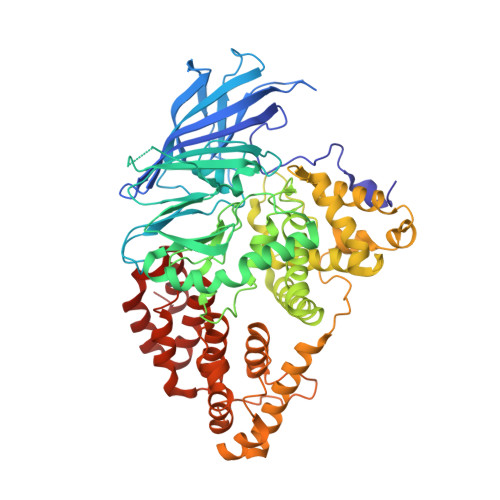A Leukotriene A(4) Hydrolase-Related Aminopeptidase from Yeast Undergoes Induced Fit Upon Inhibitor Binding.
Helgstrand, C., Hasan, M., Usyal, H., Haeggstrom, J.Z., Thunnissen, M.M.G.M.(2011) J Mol Biology 406: 120
- PubMed: 21146536
- DOI: https://doi.org/10.1016/j.jmb.2010.11.059
- Primary Citation of Related Structures:
2XPY, 2XPZ, 2XQ0 - PubMed Abstract:
Vertebrate leukotriene A(4) hydrolases are bifunctional zinc metalloenzymes with an epoxide hydrolase and an aminopeptidase activity. In contrast, highly homologous enzymes from lower organisms only have the aminopeptidase activity. From sequence comparisons, it is not clear why this difference occurs. In order to obtain more information on the evolutionary relationship between these enzymes and their activities, the structure of a closely related leucine aminopeptidase from Saccharomyces cerevisiae that only shows a very low epoxide hydrolase activity was determined. To investigate the molecular architecture of the active site, the structures of both the native protein and the protein in complex with the aminopeptidase inhibitor bestatin were solved. These structures show a more spacious active site, and the protected cavity in which the labile substrate leukotriene A(4) is bound in the human enzyme is partially obstructed and in other parts is more solvent accessible. Furthermore, the enzyme undergoes induced fit upon binding of the inhibitor bestatin, leading to a movement of the C-terminal domain. The main triggers for the domain movement are a conformational change of Tyr312 and a subtle change in backbone conformation of the PYGAMEN fingerprint region for peptide substrate recognition. This leads to a change in the hydrogen-bonding network pulling the C-terminal domain into a different position. Inasmuch as bestatin is a structural analogue of a leucyl dipeptide and may be regarded as a transition state mimic, our results imply that the enzyme undergoes induced fit during substrate binding and turnover.
- Centre of Molecular Protein Science, Lund University, Getingevägen 60, SE 22100 Lund, Sweden.
Organizational Affiliation:



















